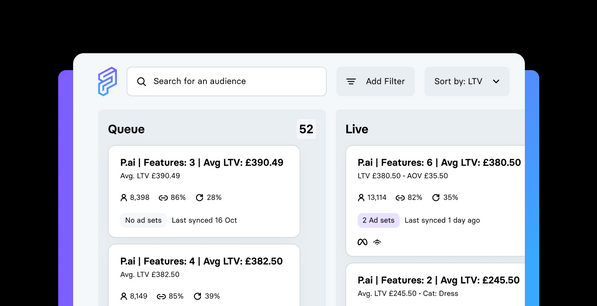“Single-lens, siloed marketing is going to become obsolete. Performance marketing works best when it’s holistic.”
EDITOR’S NOTE:
We caught up with Michael Lorenzos, Head of eCommerce Growth at Bleach London, after reading his thinkpiece on D2C performance marketing truths and nodding at the screen…
We asked him whether a marketing world with no measurement was a dystopia or utopia.
His answer?
Somewhere in between.
“Measuring through cookies was always a phase we were going to grow out of. Now it’s about getting back to the basics: how do you influence someone? How do you deliver the right message to the right person at the right time?”
After cutting his teeth in digital marketing alongside Oren Greenberg at Kurve, Michael then went from digital marketing at Manual to the Head of eCommerce Growth at Bleach London.
Key takeaways include:
- The most dangerous trap as a performance marketer
- Why Marketing Mix Models will soon become the norm
- How to create a win-win relationship with finance
Transcript edited for brevity.
Emma: You studied Marketing in Athens and have spent the last five years in digital marketing. Tell us about your journey in digital marketing, right up to heading up Performance and Ecomm Growth at Bleach London.
Michael: I find the ability to influence people fascinating. As an introvert, it wasn’t something I was particularly good at. But the idea that you can send out a message and persuade someone to buy? That felt like a superpower. It still does.
A few years after graduating, I decided I wanted to focus on digital marketing. In 2016, I joined Kurve and worked directly with Oren Greenberg as his right-hand man for three years.
Working with Oren and starting agency-side was a great shortcut to working with amazing clients. From there, I joined the team at Manual. Everything they did was data-driven, and always around improving a specific KPI. I often felt like the weak link of the team but that’s exactly the environment I want to be in.
After seeing the D2C engine in action at Manual, it was a natural step to move to Bleach London. I joined as their Head of Performance Marketing in 2020.
Emma: The last year has been pretty turbulent for many reasons. How do you think the regulatory changes (iOS 14+), compounded by the macro, is changing the way we market?
Michael: Marketing through the lens of a single channel is going to become obsolete. The idea that every single order can be attributed to a single channel? That’ll fade.
It’ll no longer be possible to look at your Source/Medium report on Google Analytics (GA) and expect an accurate measure of your customer. These changes highlight what’s already true: you can’t rely on GA or cookie-based attribution to determine your marketing mix.
The GA report hides a lot of cause and effect. For our organic social team, their work is so much more than what their attributions on Google Analytics say. As marketers, it’s our job to find correlations, detect anomalies in the data, then show others in the business the relationship between the report and the actuals.
The Source/Medium report might say that Brand Search is the best traffic source – but that’s not a marketing channel that’s easy to scale. It’s the net result of all other activity in the business. It could be an organic activation from an out of home campaign, PR or influencer marketing. If your blended CAC stays the same and volume of conversions increases, that’s a win whether or not the session-level data suggests that Facebook’s cost is higher.
All of this doesn’t mean that the GA report in itself isn’t useful. It’s still useful to see the behaviour broken down by last click and also look at your visitor’s behaviour through the funnel (shout out to Jason Spanomanolis for the amazing GA funnel reports he’s been creating for years).
You just can’t use it in isolation or use it to inform your budget decisions. That’s myopic. Performance marketing is an engine that works best when it’s holistic. Success is having a team who can set the direction and make marketing homogenous across all touchpoints – with each team working together towards a common goal. Don’t be bound by your last-click attribution.
Emma: What’s your advice for managing expectations with finance?
Michael: If you have the historic data, frame your budget request with past historical data and scenario-based thinking. “If we do x, then here are the three scenarios”.
Then work with finance to understand what level of risk you’re comfortable with. It’s not a case of us getting what we need from finance. It’s about creating a win-win relationship with them: not seeing them as the guardians of cash that allow us to do our job.
It’s about creating a win-win relationship with finance: not looking at them as the guardians of cash that allow us to do our job.
Emma: This is a leading question because I think I know the answer from your piece. But where does incrementality fall into this? Why does it matter?
Michael: Incrementality is why we do all of this in the first place. It’s the first question from anyone in finance or the C-suite, and where tools like Incrementality Testing in Facebook or marketing mix modelling come into play.
If you want incrementality and broad audiences, you need to structure your Paid Social accounts towards prospecting. Any conversion from a prospecting campaign that excludes website visitors and existing customers is bound to have a higher incrementality versus retargeting.
We know that with retargeting, there’s always a segment of people that will convert anyway. This becomes even more evident in Retention campaigns.
It’s a challenge to acquire a customer when they have no touchpoints. You have to focus on prospecting to either convert them directly or hook them into a retargeting audience where they’ll be more receptive.
As we gear up for Black Friday, we’re front-loading our prospecting spend in the run-up then will do a back-flip. Once promos are in, I’ll invert the spend and make it focused on Retargeting and Retention. That’s where I see the biggest opportunity to drive incremental uplift with customers who are more likely to convert, exactly because they’re already in our audience.
Emma: If the prophecies of a marketing world without specific measurement come true – dystopia or utopia?
Michael: Somewhere in between. Whatever the change is, it’s positive! Measuring through cookies was always a phase we were going to grow out of. Now, it’s about getting back to the basics: how do you influence someone? How do you deliver the right message to the right person at the right time?
You don’t need super granular cookie-level reporting to know if your marketing worked. Instead, I think we’re going to see marketing mix models become the norm. Especially for brands like ours that have both retail and digital presence, we have to see marketing as a holistic effort: no more dichotomy between brand vs. marketing.
The best marketers will be those that can zoom in and out, and are happy to experiment with more channels – even the unconventional ones that don’t make sense from a measurement perspective. Some people will argue that to invest in a channel, you have to invest the same in measurement. But at some point, we have to get ok with not knowing.
The best marketers will be those that can zoom in and out, and are happy to experiment with more channels – even the unconventional ones that don’t make sense from a measurement perspective.
If you want to improve performance, zoom out.
Moving forwards, everything will be about correlation. The world’s leading brands with massive marketing budgets have been spending on brand campaigns for years with tangible outcome but no cookie-level attribution. I think that’s where we’re all headed. Marketing has come full circle.
About Programmai
We’re the predictive marketing technology that makes activating your first-party data effortless. Build predictive audiences that give you the incremental edge, and let them sync to the ad platforms in a couple of clicks.
Find out more about our platform here.
And to stay updated, please follow us on LinkedIn.



